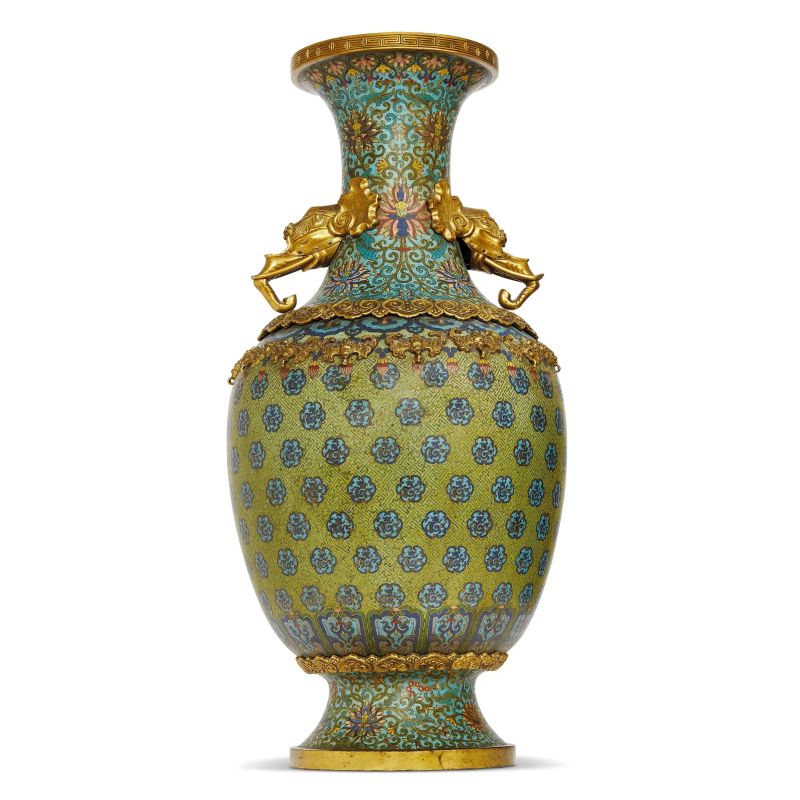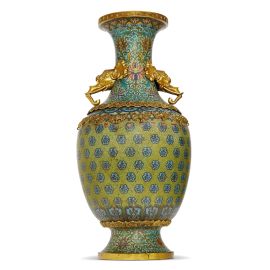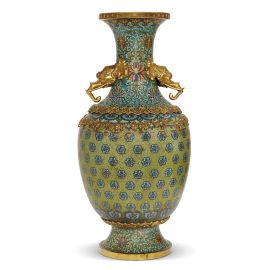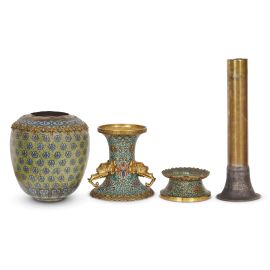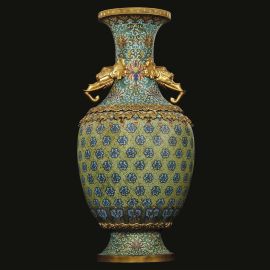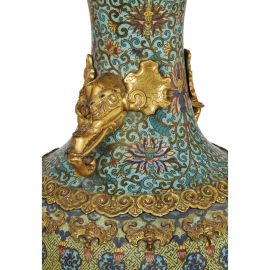A VASE, CHINA, QING DYNASTY, QIANLONG-JIAQING PERIOD
in cloisonné in the shape of a revolving heart with complex enamel decorations, decorated with the motif of the Kui dragon, symbol of authority and power, lotus flowers with enveloping branches, finished with blue, yellow-green and gold enamels. A similar vase, different in height, is today found in the Palace Museum in Beijing, testifying to the rarity and beauty of this object - Enamels, vol. 3, no. 111 (fig. 1).
清 乾隆嘉庆 铜胎掐丝珐琅秋香黄绿地夔龙锦纹象耳转心瓶
高70厘米 颈高 28,8厘米 底高 10,5厘米 腹高 36厘米 与北京故宫博物院珐琅器档案,第三卷 第111页(图1)相似
VASO, CINA, DINASTIA QING, PERIODO QIANLONG-JIAQING
in cloisonné a forma di cuore girevole con complesse decorazioni in smalto, decorato con il motivo del drago Kui simbolo di autorità e potenza, fiori di loto con rami avvolgenti, rifinito con smalti azzurri, giallo-verdi e dorati. Un vaso similare, differente per l'altezza si trova oggi al Museo del Palazzo di Pechino, a testimonianza della rarità e bellezza di questo oggetto - Enamels, vol. 3, no. 111 (fig. 1).
Alt. cm 70 Tubo centrale Alt. cm 58 Collo Alt. cm 28,8 Base Alt. cm 10,5 Corpo Alt. cm 36
Cloisonné was considered a unique symbol of imperial power and wealth during the Ming and Qing dynasties as the cost of production was high and it was mainly used as an imperial object and rarely seen among the common people. After the end of the Qing dynasty and during the period of the Republic of China, this technique spread outside the imperial court, but prices on the market increased considerably, giving it a high collector's value and earning it the name 'one piece of Cloisonné is worth as much as ten pieces of imperial porcelain'.
Cloisonné, also known as 'Jingtailan (景泰蓝)', is made by stringing thin copper wires into various design shapes, attaching them to the copper support, and then filling the spaces with different coloured enamels according to the design requirements. Finally, it is fired in the kiln repeatedly until the enamel covers the object with the desired thickness, then it is polished and gilded. According to the treatise 'Ge Gu Yao Lun: treatise on kiln pots' written by Cao Zhao at the end of the Yuan dynasty and the beginning of the Ming dynasty: 'Islamic kilns use copper as the body and use medicinal herbs to burn in five floral colours, similar to Franconian inlay... also called the kilns of foreign countries." It can be seen that Cloisonné enamel was introduced to China from the Arab region in the mid-13th century and reached its peak during the reign of Jing Tai in the Ming dynasty. During the Qing dynasty, the technique reached greater maturity.
This vase features luxurious and intricate workmanship, making this object a true masterpiece. The vase has a slightly everted rim, a long narrow neck and an ovoid body on a flat foot with elephant ear decoration on the sides of the neck. The vase consists of three parts: an upper rim from the narrow neck that flows into the ovoid body of the vase made separately, which in turn rests on the base with a trumpet foot. The body of the vase thus inserted can rotate. The neck and base are covered with sky-blue Cloisonné enamel with enveloping lotus motifs, mixed with motifs of flowers and fruits, berries and banana leaves; the shoulders are divided into gilded sections with motifs of clouds, a symbol of good omen, and bats; finally, the joint is decorated with a gilded cord motif; the body is covered with yellow-green enamel in the traditional Chinese colour '秋香色' (qiū xiāng sè).
This colour is called 'of the fragrant autumn' called '秋香色' (qiū xiāng sè), whose origins are obscure, became a colour reserved for the elite during the Qing dynasty. In the book '清稗类钞-服饰' (Qīng bài lèi cháo - fúshì) it is recorded: 'The colour of autumn, initially worn as ceremonial dress by the crown prince at the beginning of the country's founding period, was reserved exclusively for the use of the nobility, while the common people were forbidden to wear it. The '清史舆服志' (Qīng shǐ yú fú zhì) states that the emperors wore 'court robes of the colour "秋香色" (qiū xiāng sè)'.
The colour '秋香色' (qiū xiāng sè) is a shade reminiscent of the scent of trees and herbs during the autumn season. It is a stable, yellow colour slightly inclined to green, similar to a light olive green, but it is not the usual pale yellow, dark green or green-yellow; rather, it is a mysterious colour.
The main motif of the Kui dragon motif (夔龙)amidst the undulation of the motif in the shape of a million words, the Kui dragon symbolises supreme authority and divine power and represents supreme authority and dignity, which is worn as a garment in important ritual ceremonies, bringing good fortune and longevity, the decoration of the whole object is fine, the colours are noble, the layout is refined.
Even rarer is the fact that the revolving heart bottle shape is a type of vase created and fired during the Qing dynasty, with a complex technique and high firing difficulty. Xu Zhiheng wrote in 'Yinliu Zhai Shuo Ci' that 'Inside the pot is another revolving bottle, called a 'revolving heart'.

